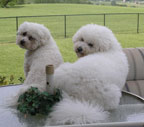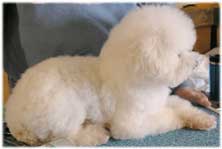Tips
To Avoid Dehydration
Maintaining a constant fluid level is as important in dogs
as it is in humans.
1. Dogs lose
a lot of water while panting. Leave two or three bowls
filled with water around the house, so that he gets
enough to drink.
2. If he has not had a good drink for a long time,
start re-hydration slowly ... allowing your dog a few
sips every few minutes. Overdrinking after a dry
spell can quickly lead to vomiting and he may end up
losing more fluids than he had.
3. Don't let your dog drink excessive amounts of water
after a strenuous exercise session.
4. Wait a few minutes after your dog has exerted in very
heavy exercise and then allow frequent but small amounts
every few minutes.
5. If your dog is showing some signs of
dehydration, give him electrolyte mixed in water. While
water helps in replenishing a lot of nutrients,
electrolyte can do the job more quickly.
6. Dogs who have gone a long time without water have a
problem holding it down. So let him lick ice, he
hydrates himself with licking the ice.
7. If your dog refuses to
drink for any extended period of time, consult your
veterinarian immediately!
Dogs lose fluid through:
breathing
panting elimination
diarhea
vomiting fever
evaporation through the feet and other body surfaces.
Dogs replenish fluid by drinking water or other liquids and
by eating moist foods. A relatively small drop
in body fluid (4-5%) can result in visible signs of
dehydration.
Symptoms of dehydration . .
.
1.
The skin loses elasticity as it loses moisture.
This can be somewhat
misleading since younger and fatter dogs will have more
elasticity than older, thinner dogs. It is important to
have an idea of what your dog's skin looks and feels like on
a normal basis. Pinch a little skin between your thumb and
forefinger on your dog's back. When you release it, it
should pop back into place immediately. (You can try this
on the back of your own hand as an example) As the tissue
under the skin loses moisture, the skin moves back more
slowly. In extreme cases, the skin doesn't pop back.
2.
The eyes appear sunken and lack moisture.
3.
The
mouth appears dry. ... gums and nose are dry.
4. Delayed capillary refill time
Pull up your dog's lip and
look at his gums. Place your index finger firmly against
the gums so that they appear white. Remove your finger and
see how quickly the blood returns to the gums (they will
become pink in that area again). This is called capillary
refill time. If you do this when everything is normal, you
will have a basis upon which to compare. The gums of a
normal dog refill immediately, the gums of a dehydrated dog
could take 3 seconds or so to return to their pink state.
If your dog shows visible symptoms of dehydration,
he may need a trip to the vet for immediate replenishment of
fluids. In serious cases, your veterinarian may administer
fluids under the skin or directly into the blood stream.

